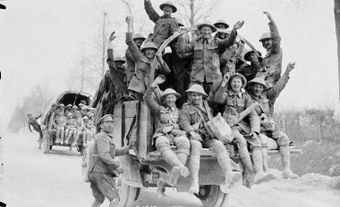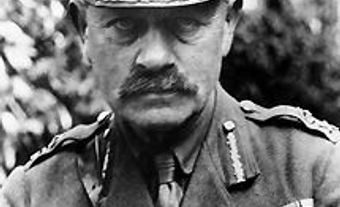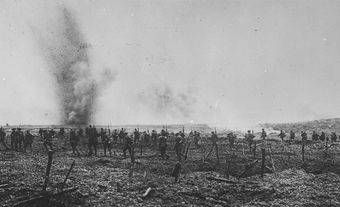Vimy Ridge is in northern France. From 9 to 12 April 1917 the Canadian Corps fought a battle against the German army there. It was on the Western Front in the First World War. The Canadians won. The Canadian Corps was made up of four divisions. This was the first time they fought together. More than 10,000 Canadians were killed and wounded. Many Canadians believe Vimy Ridge gave birth to the Canadian nation. Not everyone believes this.
This article is a plain-language summary of “The Battle of Vimy Ridge”. If you are interested in reading this about this topic in more depth, please see the full-length entry, Battle of Vimy Ridge.

Part of Arras Offensive
The Battle of Vimy Ridge was part of the Arras Offensive. By 1917, the Allied and German armies were stuck in a stalemate on the Western Front. Millions of soldiers had been killed. Both sides were stuck where they were. The war seemed like it would never end. The Allies decided to launch an attack in spring 1917. They hoped to break through the German lines. The French would attack near the Aisne River. The British would attack near the town of Arras. The Canadians were part of the British attack. They had to take Vimy Ridge. It was a 9 km long escarpment north of Arras.
The Canadian Corps was made up of four divisions. This was the first time they would fight together. They were helped by the 5th British Division. The commanding officer, Sir Julian Byng, was British. So were many other officers.
Preparing for the Battle
Canadian soldiers practiced a lot before the Battle of Vimy Ridge. They practiced what they were going to do during the battle. They also built roads, tunnels and trenches. The First World War was a war of trenches. Soldiers fought, slept and died in the trenches. Before the battle, soldiers built 11 tunnels. In total, the tunnels were 6 km long. The tunnels helped protect the soldiers when they attacked.
New Tactics
New tactics were used during the battle. First, soldiers were told that they should think for themselves. They could change tactics if they needed to. Before, they had to wait for orders. Second, soldiers had different jobs. They didn’t all use rifles. Some had machine guns. Some threw grenades. Some were engineers. Third, artillery was very important. Artillery provided something called a “creeping barrage.” This meant that artillerymen would bomb positions in front of the advancing soldiers. This forced German soldiers to stay in their bunkers. They couldn’t shoot their machine guns at the Canadians.
The Attack
The artillery shelled the Germans for a week before the attack. The Canadians attacked on 9 April in the early morning. About 15,000 Canadians advanced in the first wave. The artillery continued to shell the German trenches. At the same time, 150 machine guns fired on the Germans. When the Canadians reached the trenches, they fought hand to hand.
In one section the Canadians pushed the Germans back 5 km. This was the biggest Allied advance by that point. In other sections of the ridge, including Hill 145, the Germans were harder to defeat. It took the Canadians until 12 April to finally take the last high point, called the “Pimple.” The Canadians had finally won the Battle of Vimy Ridge. But more than 10,000 Canadian soldiers were killed or wounded. There were many German casualties too.

The Legacy of Vimy Ridge
Canadians at home were very proud of the victory. They also started to say that Vimy Ridge gave “birth” to the Canadian nation. Why? This was the first time the Canadian Corps fought as a group. It gave Canadians a sense of unity and a separate identity from Britain. It therefore contributed to nationalism in Canada.
But some scholars say that much of what we think about Vimy is a myth. First, they point out that Julian Byng and many officers in the Canadian Corps were British, not Canadian. The Canadians were also helped by the British 5th Division and by British artillery. Second, even though the battle was important, it didn’t lead to Allied victory in the First World War. Despite this, many Canadians believe the Battle of Vimy Ridge was very important in the making of Canada.

 Share on Facebook
Share on Facebook Share on X
Share on X Share by Email
Share by Email Share on Google Classroom
Share on Google Classroom




